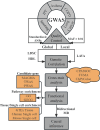Shared genetic aetiology of respiratory diseases: a genome-wide multitraits association analysis
- PMID: 38834332
- PMCID: PMC11163672
- DOI: 10.1136/bmjresp-2023-002148
Shared genetic aetiology of respiratory diseases: a genome-wide multitraits association analysis
Abstract
Objective: This study aims to explore the common genetic basis between respiratory diseases and to identify shared molecular and biological mechanisms.
Methods: This genome-wide pleiotropic association study uses multiple statistical methods to systematically analyse the shared genetic basis between five respiratory diseases (asthma, chronic obstructive pulmonary disease, idiopathic pulmonary fibrosis, lung cancer and snoring) using the largest publicly available genome wide association studies summary statistics. The missions of this study are to evaluate global and local genetic correlations, to identify pleiotropic loci, to elucidate biological pathways at the multiomics level and to explore causal relationships between respiratory diseases. Data were collected from 27 November 2022 to 30 March 2023 and analysed from 14 April 2023 to 13 July 2023.
Main outcomes and measures: The primary outcomes are shared genetic loci, pleiotropic genes, biological pathways and estimates of genetic correlations and causal effects.
Results: Significant genetic correlations were found for 10 paired traits in 5 respiratory diseases. Cross-Phenotype Association identified 12 400 significant potential pleiotropic single-nucleotide polymorphism at 156 independent pleiotropic loci. In addition, multitrait colocalisation analysis identified 15 colocalised loci and a subset of colocalised traits. Gene-based analyses identified 432 potential pleiotropic genes and were further validated at the transcriptome and protein levels. Both pathway enrichment and single-cell enrichment analyses supported the role of the immune system in respiratory diseases. Additionally, five pairs of respiratory diseases have a causal relationship.
Conclusions and relevance: This study reveals the common genetic basis and pleiotropic genes among respiratory diseases. It provides strong evidence for further therapeutic strategies and risk prediction for the phenomenon of respiratory disease comorbidity.
Keywords: Asthma; COPD ÀÜ Mechanisms; Interstitial Fibrosis; Lung Cancer; Sleep apnoea.
© Author(s) (or their employer(s)) 2024. Re-use permitted under CC BY-NC. No commercial re-use. See rights and permissions. Published by BMJ.
Conflict of interest statement
Competing interests: None declared.
Figures





Similar articles
-
Role of the Gut-Brain Axis in the Shared Genetic Etiology Between Gastrointestinal Tract Diseases and Psychiatric Disorders: A Genome-Wide Pleiotropic Analysis.JAMA Psychiatry. 2023 Apr 1;80(4):360-370. doi: 10.1001/jamapsychiatry.2022.4974. JAMA Psychiatry. 2023. PMID: 36753304 Free PMC article.
-
Shared genetic etiology of vessel diseases: A genome-wide multi-traits association analysis.Thromb Res. 2024 Sep;241:109102. doi: 10.1016/j.thromres.2024.109102. Epub 2024 Jul 20. Thromb Res. 2024. PMID: 39059088
-
Shared genetic correlations between kidney diseases and sepsis.Front Endocrinol (Lausanne). 2024 Jul 17;15:1396041. doi: 10.3389/fendo.2024.1396041. eCollection 2024. Front Endocrinol (Lausanne). 2024. PMID: 39086896 Free PMC article.
-
Genetic risk factors for the development of pulmonary disease identified by genome-wide association.Respirology. 2019 Mar;24(3):204-214. doi: 10.1111/resp.13436. Epub 2018 Nov 13. Respirology. 2019. PMID: 30421854 Review.
-
Multivariate analysis of genome-wide data to identify potential pleiotropic genes for type 2 diabetes, obesity and coronary artery disease using MetaCCA.Int J Cardiol. 2019 May 15;283:144-150. doi: 10.1016/j.ijcard.2018.10.102. Epub 2018 Oct 31. Int J Cardiol. 2019. PMID: 30459114 Review.
References
MeSH terms
LinkOut - more resources
Full Text Sources
Miscellaneous
